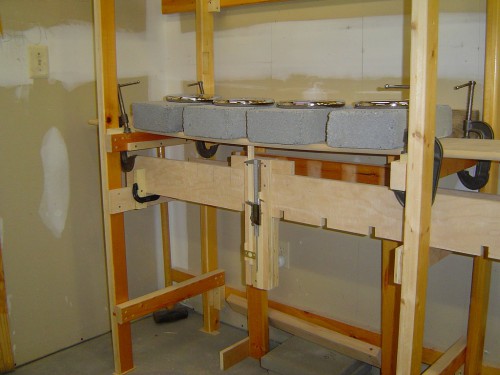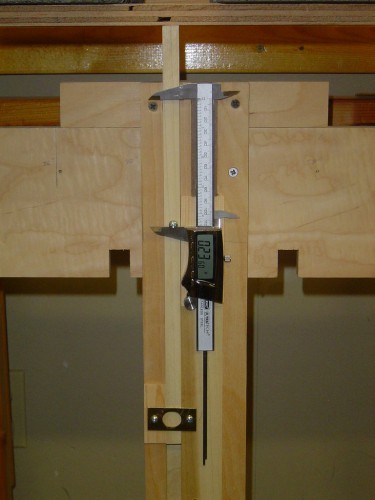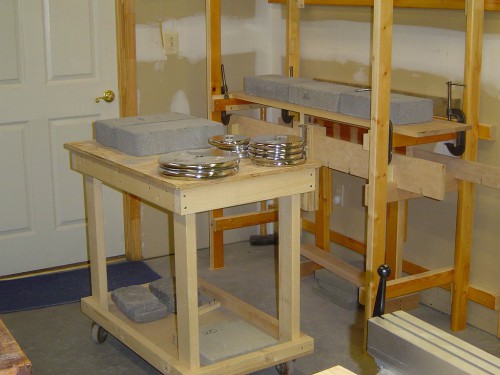I call this apparatus a shelf deflectometer. It’s used to measure shelf deflection or sag in order to test various shelf construction and loading parameters. (I would call it a “sagometer” but there’s already a device by that name used to measure sag in electrical power lines). The impetus for building it was to facilitate the collection of a large number of shelf sag measurements in order to create shelf sag tables that could quickly be referenced when it comes time to build bookcases.
The 2 x 4 framework of the deflectometer came from an old futon bed. It consists ofladder-like uprights on each end that are screwed to the wall for stability. Each upright has four “rungs” or cross pieces. One of these, located 36 inches above the floor, functions as a shelf support ledge. It accommodates a shelf up to 16 inches deep.
Plywood stretchers with notches cut in them at 6 inch intervals are used to set the shelf width. The slots fit over mating cross pieces on the uprights, further stabilizing the whole apparatus. Shelves spanning 24 to 60 inches can be accommodated with the spacers shown here. A stretcher directly below the front edge of the shelf holds the shelf deflection measuring component.
The deflectometer can handle a variety of shelf support/mounting techniques. Free floating shelves rest on top of the support ledges without their ends being secured to the ledges. Fixed shelves are secured to the support ledges with either clamps or screws. Front and rear shelf supports are also accommodated. For front support, an edging strip up to 2″ wide can be screwed to the underside of the shelf. The ends of the strip sit on cleats running the length of the shelf ledge. A contraption resembling a runner’s hurdle is used to support the rear edge of the shelf. It consists of a wooden beam spanning two adjustable legs. It simulates a support cleat attached to the shelf back.
The shelf slides in from the right side to position it for sag measurements. Any excess length protrudes to the right of the upright. That’s the advantage of an open ladder framework — a single board can be used for multiple shelf span measurements without having to cut the board to size each time.
The photo below depicts the deflection measuring component. A digital caliper is attached via double-sided tape to a piece of plywood. The plywood is secured to a stretcher below the shelf. Adjacent to the caliper is a groove that accepts a 1/2″ wide wooden rod with a protruding screw attached to the middle of it. As the rod slides down in response to the weighted shelf pushing down on its top end, the screw moves the lower jaw of the caliper. If the caliper is zeroed before any weights are placed on the shelf, the recorded caliper movement represents the shelf deflection. That’s all there is to it.
Once a shelf is in position and supported in the desired manner (e.g., ends clamped to the ledge and front edging screwed in place), the caliper rod is gently pushed up against the underside of the shelf and the caliper is zeroed by pushing a button. This is the neutral or non-sag position. The desired load is then applied to the shelf. Invariably, the shelf will bounce a little as the weights are placed on it so I take out any play by pushing the rod tight against the shelf before recording the deflection measurement.
For shelf loading, solid concrete blocks (20 and 25 pounds) and barbell weights (5, 10, 25 pounds) work well. The concrete blocks in particular do a good job of simulating a uniformly loaded book shelf because they have a relatively large footprint that helps to spread the load.
I built a companion cart to keep the weights close at hand for loading/unloading the shelves. It can also be easily rolled out of the way when adjusting the deflectometer. When taking hundreds of deflection measurements – as for the afore-mentioned shelf sag tables – a cart like this saves lots of time and reduces muscle fatigue. It was well worth the hour spent building it from scrap wood…






It’s amazing. Thanks for sharing
working with wood is a great fun. I love this awesome strategy.
I’m curious to see how your numbers match with the Sagulator on this site!! Awesome build 🙂
Feel free to compare! This page contains some of my own comparison results:
https://staging.woodbin.com/ref/shelf-sag-measurements/
There are already engineering tables and calculations to calculate deflection (sag) of any size and length of wood beam subject to uniform, unbalanced or point loads. Get yourself a copy of a Timber design Manual